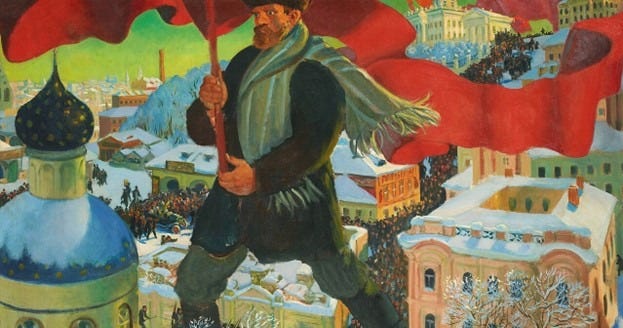The first hundred days of Donald Trump’s second presidency richly deserve to be called “the hundred days that shook the world.”1 Even the greatest Trump detractors seem to be taken aback by the sheer intensity of chaos that was inflicted on us since January 20. Most attempts to make sense of it range between two extremes. One is that Trump is playing a deep game of five-dimensional chess. The opposite one is that he is simply a malevolent psychopath.
I leave it to others to argue about personal motivations. Let’s dive below the surface of all that “sound and fury,” instead shifting the focus of analysis to the structural level (as is my general approach in Cliodynamica).
I propose the following syllogism:
We are in revolution
Revolutions destroy
Let’s take each of these assertions in turn. First, that we are in revolution is now generally accepted, but it’s worth placing it in the historical context. Most famous revolutions (such as the French and the Russian) had two characteristics. They were revolutions of the elites, in which the previous ruling class was overthrown and replaced by a coalition of counter-elites. And these revolutions were transformational—they aimed to dramatically change the society’s institutional make-up. I think it is not controversial that the rise to power by the counter-elite coalition led by Trump satisfies both these principles (I expand on this point in an article in the Guardian, The deep historical forces that explain Trump’s win). Whether this revolution will be successful (in either elite replacement or societal transformation, or both) the future will tell.
Next, why are revolutions primarily destructive? This is most vividly explained by the Internationale. Here’s my translation of the key stanza from the Russian version, which was the most influential as it was the USSR anthem before World War II:
We will demolish this world of oppression
Down to the foundations, and then
We will build our own, new world.
Those who were nothing will become everything!
The Bolshevik, painting by Boris Kustodiev
In other words, before building the new world, the old one needs to be destroyed down to the foundations. In real life, revolutions were much better at destruction than creation. The struggle for power between the counter-elites and the established elites necessitates an attack on their organizations, on institutional arrangements that favor them, and on their ideology.
There are also compelling reasons for destroying the old world that go beyond the struggle for power. Transformative revolutions typically succeed only when mobilizing large majorities in support of overthrowing the old regime. This is much easier to do when the world created by the ruling elites is widely perceived as unjust and unfair.
After the USSR fell, America achieved an unprecedented degree of world domination along all important dimensions: geopolitical, geoeconomic, and geocultural. Perceptions of Pax Americana differ widely, depending on whether you are in Washington DC compared to Iran, Venezuela, or even Wyoming.2 One side sees the spread of democracy, human rights, and prosperity brought by international trade. The other side sees unprovoked military attacks, violent regime change, deindustrialization and immiseration, and imposition of alien cultural norms.
The world built by America over the past several decades benefited some at the expense of others. The problem is that the beneficiaries were not even the “golden billion,” but only a small part of it—mostly the 1 percent, and to a lesser degree the 10 percent.3 You wouldn’t understand it if you read only the mainstream, or more accurately, the corporate media, because it is controlled by the rulers. You would get a very different take on RT (Russia Today, banned in Europe) or the alternative media in the US (one long-time and influential critic of the American ruling class and the world it built has been Tucker Carlson).
The corporate media, thus, is panicking about the Trump chaos. The Economist has had three covers in a row about it.4
But Trump’s constituents are celebrating. Many of them self-identify as revolutionaries, such as Steve Bannon or Jason Hinkle (a proponent of what he calls “MAGA communism”). Robert Stark recently gathered together an impressive number of quotes from Trump supporters (see How MAGA Communism Will Make America Great Again By Crashing The Economy: Trump supporters are celebrating economic collapse to own the libs).
Natalie Winters, a White House correspondent and co-host of the War Room podcast with Steve Bannon, expressed this revolutionary enthusiasm best: it’s “welcome chaos, joyful chaos” (Bannon’s WarRoom, Show Clip Roundup 21 April 25 [PM], from approximately 12:00).
Circling back to the beginning of this post. To make sense of what’s going on we need not psychoanalysis, but structural analysis. It doesn’t matter what’s inside Trump’s mind. He is doing what the MAGA movement wants him to do.
Chaos is not a bug; it’s a feature.
With apologies to John Reed (see Ten Days That Shook the World)
Where 71.6% voted for the Trump/Vance ticket.
Image thanks to John Mauldin’s Thoughts from the Frontline.






I am so glad you are on Substack.
MAGA didn’t elect a President. They purchased a weapon of mass destruction to use on their enemies. And they are using it with glee. Unfortunately they are horrifying the rest of the world, chasing off scientists and experts, and kicking the legs out from under the dollar’s dominance. Their ‘purified’ nation will be a much less important one. It will be much safer to watch this from a distance.